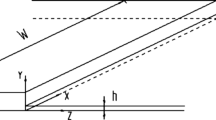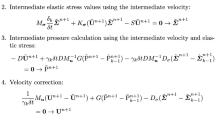Abstract
The high Weissenberg number problem (HWNP) has been regarded as a key challenge in computational rheology. Developing stable and flexible numerical methods for simulating highly elastic fluid flows has become the major research subject of scholars. In this work, we present a new stabilized high-order discontinuous Galerkin (DG) method to simulate viscoelastic flows at high Weissenberg (Wi) numbers. To decouple the velocity and pressure, and circumvent the limitation of the Ladyzhenskaya–Babuška–Brezzi condition, the dual splitting scheme based on the implicit backward differentiation formula and explicit extrapolation scheme is performed for the momentum and mass equations. In addition, integration by parts of the pressure gradient term in projection step and the velocity divergence term in pressure Poisson equation is required to enhance the numerical stability of the method at small time steps. To guarantee the positive definiteness of the conformation tensor and improve the computational stability at high Wi numbers, the square-root-conformation representation (SRCR) approach is applied to reconstruct the constitutive equation. Meanwhile, the second-order Runge–Kutta scheme is performed for temporal discretization and the local Lax–Friedrichs flux is employed for the nonlinear convective term to tackle the convection-dominated problems. The resulting numerical method is free from iterative errors, and does not require any additional stabilization term, which gives an efficient and easy-to-be-implemented solver for viscoelastic flows. The numerical study considers different viscoelastic flow problems, including the Poiseuille flow in a channel, the lid-driven cavity flow, the flow past a fixed cylinder and the flow around an oscillating cylinder. The numerical results reveal the high-order accuracy and robustness of our method at high Wi numbers. Compared with the scheme in the literature, the presented method is more flexible in complex irregular regions and much easier to construct the high-order format. This is the first attempt to apply SRCR scheme in framework of DG method, which provides a new efficient high-order method for simulating complex viscoelastic flows at high Wi numbers.

















Similar content being viewed by others
References
Farid M, Ghani AGA (2004) A new computational technique for the estimation of sterilization time in canned food. Chem Eng Process 43(4):523–531
Chen Y, Liang Y, Liu H, Wang X, Wang J (2021) Extrusion of wheat gluten-peanut oil complexes and their rheological characteristics. Food Chem 364:130435
Kim CA, Kim JT, Lee K, Choi HJ, Jhon MS (2000) Mechanical degradation of dilute polymer solutions under turbulent flow. Polymer 41(21):7611–7615
Mortazavi R, Mortazavi S, Troncoso A (2021) Wrapper-based feature selection using regression trees to predict intrinsic viscosity of polymer. Eng Comput 2:1–13
Anand M, Kwack J, Masud A (2013) A new generalized Oldroyd-B model for blood flow in complex geometries. Int J Eng Sci 72:78–88
Khurshid H, Hoffmann KA (2015) Development of high-order solver for blood flow. Eng Comput 31:51–71
Oldroyd JC (1950) On the formulation of rheological equations of state. Proc R Soc Lond 200(1063):523–541
Thien NP, Tanner RI (1977) A new constitutive equation derived from network theory. J Non-Newtonian Fluid Mech 2:353–365
Verbeeten WMH, Peters GWM, Baaijens FTP (2001) Differential constitutive equations for polymer melts: the extended Pom-Pom Model. J Rheol 45:823–843
Hulsen MA (1990) A sufficient condition for a positive definite configuration tensor in differential models. J Non-Newtonian Fluid Mech 38(1):93–100
Joseph DD (1990) Fluid dynamics of viscoelastic liquids. Springer-Verlag, New York
Keunings R (2000) A survey of computational rheology. In: D.B. et al. (Ed.), Proceedings of the 13th International Congress on Rheology, vol. 1, British Society of Rheology
Owens RG, Phillips TN (2002) Computational rheology. Imperial College Press, London
Walters K, Webster M (2003) The distinctive CFD challenges of computational rheology. Int J Numer Methods Fluids 43:577–596
Krank B, Fehn N, Wall WA, Kronbichler M (2017) A high-order semi-explicit discontinuous Galerkin solver for 3D incompressible flow with application to DNS and LES of turbulent channel flow. J Comput Phys 348:634–659
Dolejs̆í V, Feistauer M (2004) A semi-implicit discontinuous Galerkin finite element method for the numerical solution of inviscid compressible flow. J Comput Phys 198(2):727–746
Ferrer E, Willden RHJ (2011) A high order discontinuous Galerkin finite element solver for the incompressible Navier–Stokes equations. Comput Fluids 46(1):224–230
Fehn N, Wall WA, Kronbichler M (2017) On the stability of projection methods for the incompressible Navier-Stokes equations based on high-order discontinuous Galerkin discretizations. J Comput Phys 351:392–421
Gao PY, Ouyang J, Zhou W (2018) Coupling of finite element method and discontinuous Galerkin method to simulate viscoelastic flows. Int J Numer Meth Fluids 86(6):414–432
Mirzakhalili E, Nejat A (2015) High-order solution of viscoelastic fluids using the discontinuous Galerkin method. J Fluids Eng 137(3):031205
Chai Y, Ouyang J, Wang XD (2021) An efficient stabilized finite element scheme for simulating viscoelastic flows. Int J Numer Meth Fluids 93(6):1947–1968
Fattal R, Kupferman R (2004) Constitutive laws for the matrix-logarithm of the conformation tensor. J Non-Newtonian Fluid Mech 123(2–3):133–147
Balci N, Thomases B, Renardy M, Doering CR (2011) Symmetric factorization of the conformation tensor in viscoelastic fluid models. J Non-Newtonian Fluid Mech 166(11):546–553
Stewart PA, Lay N, Sussman M, Ohta M (2008) An improved sharp interface method for viscoelastic and viscous two-phase flows. J Sci Comput 35(1):43–61
Chen XY, Holger M, Michael S, Dieter B (2013) A comparison of stabilisation approaches for finite-volume simulation of viscoelastic fluid flow. Int J Comput Fluid Dyn 27(6–7):229–250
Guermond JL, Minev P, Shen J (2006) An overview of projection methods for incompressible flows. Comput Methods Appl Mech Eng 195(44–47):6011–6045
Ma MX, Ouyang J, Wang XD, Zhang CH (2021) A stable discontinuous Galerkin method based on high-order dual splitting scheme without additional stabilization term for incompressible flows. Int J Numer Meth Fluids 93(8):2660–2676
Claus S, Phillips TN (2013) Viscoelastic flow around a confined cylinder using spectral/hp element methods. J Non-Newtonian Fluid Mech 200:131–146
Zhou W, Ouyang J, Wang XD, Su J, Yang BX (2016) Numerical simulation of viscoelastic fluid flows using a robust FVM framework on triangular grid. J Non-Newtonian Fluid Mech 236:18–34
Karniadakis GE, Israeli M, Orszag SA (1991) High-order splitting methods for the incompressible Navier-Stokes equations. J Comput Phys 97(2):414–443
Fattal R, Kupferman R (2005) Time-dependent simulation of viscoelastic flows at high Weissenberg number using the log-conformation representation. J Non-Newtonian Fluid Mech 126:23–37
Comminal R, Spangenberg J, Hattel JH (2015) Robust simulations of viscoelastic flows at high Weissenberg numbers with the stream function/log-conformation formulation. J Non-Newtonian Fluid Mech 223:37–61
Varchanis S, Syrakos A, Dimakopoulos Y, Tsamopoulos J (2019) A new finite element formulation for viscoelastic flows: circumventing simultaneously the LBB condition and the high-Weissenberg number problem. J Non-Newtonian Fluid Mech 267:78–97
Hulsen MA, Fattal R, Kupferman R (2005) Flow of viscoelastic fluids past a cylinder at high Weissenberg number: stabilized simulations using matrix logarithms. J Non-Newtonian Fluid Mech 127(1):27–39
Castillo E, Codina R (2015) First, second and third order fractional step methods for the three-field viscoelastic flow problem. J Comput Phys 296:113–137
Kynch RM, Phillips TN (2017) A high resolution spectral element approximation of viscoelastic flows in axisymmetric geometries using a DEVSS-G/DG formulation. J Non-Newtonian Fluid Mech 240:15–33
Knechtges P, Behr M, Elgeti S (2014) Fully-implicit log-conformation formulation of constitutive laws. J Non-Newtonian Fluid Mech 214:78–87
Junior ILP, Oishi CM, Afonso AM, Alves MA, Pinho FT (2016) Numerical study of the square-root conformation tensor formulation for confined and free-surface viscoelastic fluid flows. Adv Model Simul Eng Sci 3:1–23
Williamson CHK, Roshko A (1979) Vortex formation in the wake of an oscillating cylinder. J Fluid Struct 2:355–381
Wanderley JBV, Souza GHB, Sphaier SH, Levi C (2008) Vortex-induced vibration of an elastically mounted circular cylinder using an upwind TVD two-dimensional numerical scheme. Ocean Eng 35:1533–1544
Antoine P, Sigrist JF, Hamdouni A (2009) Numerical simulation of an oscillating cylinder in a cross-flow at low Reynolds number: forced and free oscillations. Comput Fluids 38:80–100
Zhang H, Xin DB, Zhan J, Zhou L (2021) Flow past a transversely oscillating cylinder at lock-on region and three-dimensional Floquet stability analysis of its wake. Phys Fluids 33:025111
Sufyan M, Farooq H, Akhtar I, Bangash Z (2021) Pressure mode decomposition analysis of the flow past a cross-flow oscillating circular cylinder. J Mech Sci Technol 35:153–158
Donea J, Guiliani S, Halleux J-P (1992) An arbitrary Lagrangian Eulerian finite element method for transient dynamic fluid-structure interactions. Comput Methods Appl Mech Eng 33:689–723
Koobus B, Farhat C (1999) Second-order time-accurate and geometrically conservative implicit schemes for flow computations on unstructured dynamic meshes. Comput Methods Appl Mech Eng 170:103–129
Acknowledgements
This work is supported by the National Nature Science Foundation of China (Grant Nos. 11971387, 11671321, 91434201, 11901051).
Author information
Authors and Affiliations
Corresponding authors
Ethics declarations
Conflict of interest
The authors declare no conflict of interest.
Additional information
Publisher's Note
Springer Nature remains neutral with regard to jurisdictional claims in published maps and institutional affiliations.
Rights and permissions
About this article
Cite this article
Ma, M., Ouyang, J. & Wang, X. A high-order SRCR-DG method for simulating viscoelastic flows at high Weissenberg numbers. Engineering with Computers 39, 3041–3059 (2023). https://doi.org/10.1007/s00366-022-01707-5
Received:
Accepted:
Published:
Issue Date:
DOI: https://doi.org/10.1007/s00366-022-01707-5




